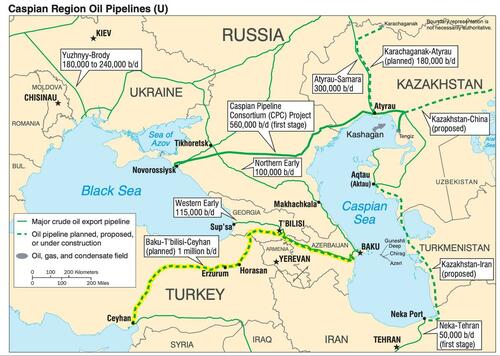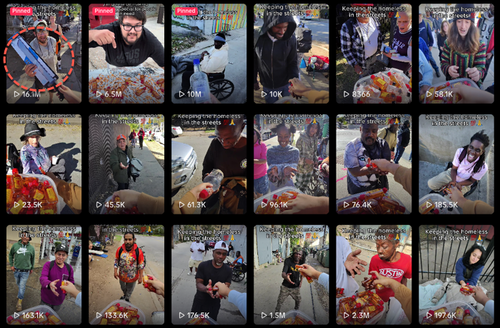The Illusion Of Progress & The Pursuit Of 'More'
Authored by Anthony Deden via Forum Geopolitica,
The Illusion of Progress
This essay was born out of revulsion to an accidental summer reading that paraded progress as virtue and private equity as its high priest. Every paragraph spoke the same pious language of “sustainable improvement,” “societal benefit,” and “longterm value creation,” as though leverage, asset-stripping, and balance-sheet cosmetics had become moral acts. I found myself revolted not merely by the hypocrisy, but by the vacuousness of it. In our hyper-financialized society, we have come to mistake valuation for value, and activity for achievement. The word ‘progress’ has been exploited to justify anything that moves—no matter what it destroys. What follows is an act of refusal to bow to the idea that more money is progress. If this essay has a motive, it is contempt for the trivial slogans that pass as thought, and for the hollow theory that confuses financial engineering with human improvement.
"Illusion is the first of all pleasures."
- VOLTAIRE. LA PUCELLE D’ORLÉANS. ÉDITION LONDON: [PUBLISHER UNSPECIFIED], 1756. EPILOGUE.

Once upon a time, progress meant a tangible conquest of necessity—something that could be seen, held, and mended. Progress was the story of men and women mastering nature through invention: the plough that turned survival into surplus, the compass that unlocked the seas, the printing press that scattered learning beyond the cloister. Each advance widened the circle of freedom and gave shape to civilization’s rise.
The eighteenth and nineteenth centuries quickened that rise. Steam compressed distance, iron bridged rivers and continents, and the telegraph carried thought at the speed of light. Gaslight and electricity stretched the day, and clean water, sanitation, and medicine pushed death to the margins of daily life. Progress could be counted in engines built, bricks laid, and diseases conquered. It was visible, measurable, and grounded in use.
Furthermore, the results were tangible. Between 1800 and 1900, average life expectancy in Western Europe rose from about 35 to 55 years. Real wages roughly tripled. Literacy spread from a minority to the great majority of the population. A factory worker’s wage could buy more food, clothing, and comfort than an artisan’s income a century earlier. A home might possess running water, heat, light, and—by the early twentieth century—affordable transport and communication. Progress was not an abstraction: it could be counted and measured.
Behind these visible achievements lay an invisible order. Enterprise rested on saving; saving depended on restraint. Honest money was scarce, redeemable, and real. It connected effort to reward and production to value. The world was built by those who produced before they consumed. Credit, too, was a bridge between past work and future creation, not a source of perpetual motion. Money and goods moved in harmony: each note represented something earned,something built.
When nations laid railways or spanned oceans, they did so with capital saved by citizens. In other words, deferred pleasures were converted into steel and stone. Inventors like Watt and Edison advanced not speculation, but service. Their genius enriched the common life.
The free market was not yet a casino but an arena of usefulness, where prosperity followed contribution. And yes, profit was evidence of having met a genuine need.
By the dawn of the twentieth century, progress had become a landscape that was visible in telegraph poles, tramways, and electric light. It carried an almost moral confidence: that man, guided by reason and effort, could make the world better in substance, not merely in symbol. Henry Grady Weaver tells us that the mainspring of progress was not energy from coal or oil, but from man himself — his imagination disciplined by liberty.When he lost faith in that freedom, his machines outlived his spirit.
Hans-Hermann Hoppe reminds us in A Short History of Man that for most of human history, progress meant learning to act rationally within limits — to use intelligence, thrift, and cooperation to transform scarcity into sufficiency. It required discipline, prudence, and the willingness to live within limits.
The real advances of mankind—from cultivation to industry—were not the gifts of invention alone but of moral order: the discovery that property, family, and saving could bind effort to consequence and turn scarcity into sufficiency. Progress was an achievement of character before it was a measure of output. It was the steady improvement of life through virtues that bound action to consequence: thrift, property, responsibility, and the protection of what one built.
Yet, by the early twentieth century, this older meaning of progress—rooted in work, discipline, and the tangible improvement of life—was already beginning to fade. The moral foundations that once joined virtue to growth began to erode. The word itself was captured by a new creed—one that mistook abstraction for achievement, and motion for improvement.
Slowly, the means of creation turned into the means of speculation.
When Finance Replaced Production
The material age that had built bridges, ships, and power stations entered the twentieth century with unshaken faith in its own momentum. Yet beneath the surface, the structure of enterprise was already changing. The tools of finance— credit, capital markets, and accounting—were invented to fund production, but they began to evolve faster than the production they were meant to serve.
In the early industrial order, money and goods moved together. The banker was the steward of accumulated savings, and the stock exchange was a meeting place between the thrifty and the enterprising. Investment was a form of partnership between labor, invention, and capital. But as the century advanced, finance detached itself from its material foundations. Paper claims multiplied far beyond the stock of tangible goods. The abstraction that had once facilitated trade began to define it.
Two revolutions hastened this separation.
-
The first was monetary: the gradual abandonment of money’s anchor in real value. Convertibility yielded to confidence; credit creation replaced saving. As Hans-Hermann Hoppe observed, when money ceases to be anchored in real value, society’s time preference inevitably rises: the future is discounted, patience gives way to immediacy, and the long view of the builder yields to the short view of the trader.
-
The second revolution was institutional: the rise of corporations whose worth came to rest less on what they produced than on what others believed they were worth. Accounting, once the record of fact, became the medium of expectation.
By the mid-twentieth century, profits no longer required production in the traditional sense. Balance sheets could expand through debt; share prices could rise through mergers, acquisitions, and later, buybacks. Speculation in financial instruments grew to rival the industries whose securities they represented.
Murray Rothbard warned that such monetary inflation does not enrich society as a whole but transfers its substance—quietly and systematically—from producers and savers to those nearest the source of new credit. What appears as growth is, in truth, redistribution masked by rising prices and expanding balance sheets.
In the end, this transformation redefined what society meant by “growth.” The prosperity of the industrialist had once rested on his capacity to make and sell useful goods; the prosperity of the financier now depended on movement within the realm of symbols—interest rates, valuations, derivatives, and expectations. The appearance of wealth became a substitute for wealth itself.
The change also altered the time horizon of enterprise. A factory demanded years of patient investment, but a financial product could be invented and sold within weeks. The long view of the builder yielded to the short view of the trader. Markets rewarded agility, not durability. The capacity to arbitrage, restructure, or repackage assets came to be regarded as a higher skill than the slow work of design and manufacture.
In this environment, the language of production gave way to that of returns. Efficiency was redefined as the reduction of costs rather than the creation of value. Whole industries were re-engineered for balance-sheet optimization rather than technological advance. A company could shrink its workforce, outsource its factories, and still be celebrated for “unlocking shareholder value.” The metric of success was no longer what was built or improved, but what the market capitalization reflected.
The cultural prestige of finance rose in parallel. The banker and fund manager replaced the engineer and merchant as models of success. Economic life migrated from workshops to screens; from things to figures. Profit became an end in itself, divorced from the human activity that had once justified it. The purpose of enterprise—serving needs through production—was eclipsed by the perpetual pursuit of financial gain.
In this new order, even money lost its solidity. It became not the record of past effort but the anticipation of future policy. Credit creation, once a bridge between savings and investment, turned into a self-replicating process: new debt to sustain old, new liquidity to sustain valuations. Guido Hülsmann later described this as the moral hazard of fiat money. That is, a regime in which falsified measures of value erode the link between action and consequence, allowing entire societies to consume the illusion of wealth while their real capital quietly decays.
Indeed, the system could grow without building anything at all,so long as confidence held.
Thus the illusion took form. Finance, which had begun as the servant of production, became its master. The making of goods receded behind the making of prices. The expansion of credit came to be celebrated as progress, and the multiplication of paper wealth as proof of prosperity. The old sequence—save, invest, produce, profit—was inverted. What had once been a measure of achievement became the object of it. The world entered an era in which the acquisition of money, detached from material purpose, was mistaken for progress itself..
False Measures — Why GDP Misleads
The illusion of progress gained its most enduring disguise in the language of measurement. Numbers replaced judgment, and the gross domestic product became the supreme idol of economic life. Conceived in the 1930s to estimate wartime output and industrial capacity, GDP was never meant to represent human welfare or civilizational advancement. It counted production for the sake of mobilization, not prosperity. Yet over time, this emergency metric came to define progress itself.
GDP measures the speed of activity, not the value or purpose of what is done. It tallies every transaction as growth, whether it builds a bridge or bombs one, whether it cultivates soil or strips it bare. The cutting of a forest, the repair of its flood damage, and the lawsuits that follow each adds to the total. Destruction and recovery register as twin booms. As stupid as it sounds, in this arithmetic, a society may spend itself into apparent wealth.
As sober economists have noted, GDP’s blindness extends beyond moral and qualitative dimensions to structural ones. It measures the economy’s endpoints while ignoring the intricate chains of production that sustain them. As Mark Skousen observed, Gross Output—what he called “the top line” of national accounting—captures this hidden architecture, whereas GDP records only the “bottom line.” The result is a statistical mirage: activity looks healthy even as the capital structure deforms. Under easy credit, GDP swells not through productive depth but through monetary distortion, mistaking inflation and malinvestment for prosperity.
This illusion deepens because GDP cannot distinguish between creation and consumption, between genuine capital formation and the liquidation of the past. It registers motion, not meaning. When a company borrows to buy back its shares, GDP rises. When financial speculation multiplies without adding a single good or service, GDP rises again. In this way, the volume of transactions is mistaken for the creation of wealth.
Such aggregates seduce policymakers into believing the economy can be managed as a single machine. Friedrich Hayek called this the fatal conceit—the belief that dispersed human action can be guided through statistical dials. To raise GDP is easy: borrow, spend, inflate, and count. But what such policies expand in figures, they often destroy in substance. Bridges decay, real wages stagnate, and the living fabric of society is consumed to sustain the illusion of growth.
Where progress once measured improvement in the quality of life and institutions, it now measures only quantity and velocity. It is only an illusion sustained by policy and finance.
Under these false measures, even decline appears as progress. Disasters, bailouts, and wars can all lift the totals. A nation that borrows and spends beyond its means looks more “dynamic” than one that saves and repairs. The more financialized an economy becomes, the larger its reported growth—because it counts turnover and speculation as production itself.
Thus a tool once devised for administration has become a mask for deterioration. GDP cannot tell us whether we are advancing or merely accelerating toward exhaustion.
When Everything Becomes an Investment
In our time, almost nothing escapes the grammar of finance. What began as the detachment of money from matter has become the detachment of value from virtue. The vocabulary of capital now governs nearly every sphere of life: art becomes an asset class, education a credential market, food a vehicle for branding, and even leisure a form of competitive display. The very word investment has swollen to include every pursuit that promises advantage, whether or not it produces anything of worth.
Private equity is the purest expression of this new creed. Its tools—leverage, optimization, and exit—belong to a world where time has been conquered and consequence deferred. Businesses once built to last are now built to sell. The craftsman’s slow accumulation of goodwill is replaced by the manager’s quick extraction of yield. When every enterprise must justify itself through “enhanced shareholder value,” the distinction between stewardship and exploitation collapses. The result is not creation but conversion of substance into symbols, and of permanence into liquidity.
The same logic pervades the ordinary. Food, stripped of season and place, becomes a derivative of chemistry and logistics. Education, once a cultivation of understanding, becomes a debt-financed speculation on employability. The financialization of everything is not merely an economic development but a metaphysical one: it teaches us to see the world not as a trust to be tended but as a balance sheet to be managed.
Here lies the moral inversion of our age. Money, which was once the servant of purpose, has become its measure. The larger yacht, the faster airplane, the greater “net worth”—these are not symbols of abundance but of dislocation. They mark the distance between possession and peace. The pursuit of more has displaced the question of what it is for. And when a civilization forgets to ask that question, it continues to advance in technique while it declines in wisdom.
An honest investment policy for such a time cannot be built upon forecasts or leverage, but upon conscience. The real measure of return is endurance: what remains when the fashion has passed, what serves when speculation ends. Capital that sustains meaning—institutions, skills, and relationships—outlasts all that merely inflates price. To invest rightly is to align money with purpose, to treat gain as the servant of continuity rather than the substitute for it.
If there is to be progress again, it will come when we understand that it is not the endless acceleration of change but the maintenance of meaning through time. It is not a line on a graph that ascends, but a circle that endures.
Only when money measures service, and success is judged by what is built and preserved rather than what is traded or displayed, will progress cease to be an illusion—and become, once more, an achievement of character.
Tyler Durden
Sun, 11/30/2025 - 18:40









 A hematologist-oncologist and former Cal-San Francisco professor, Vinay Prasad is the nation's top vaccine regulator (Kristyna Wentz-Graff / OHSU)
A hematologist-oncologist and former Cal-San Francisco professor, Vinay Prasad is the nation's top vaccine regulator (Kristyna Wentz-Graff / OHSU)





 Minnesota Gov. Tim Walz, Rep. Ilhan Omar (D-MN)
Minnesota Gov. Tim Walz, Rep. Ilhan Omar (D-MN)
 Via Reuters
Via Reuters









Recent comments